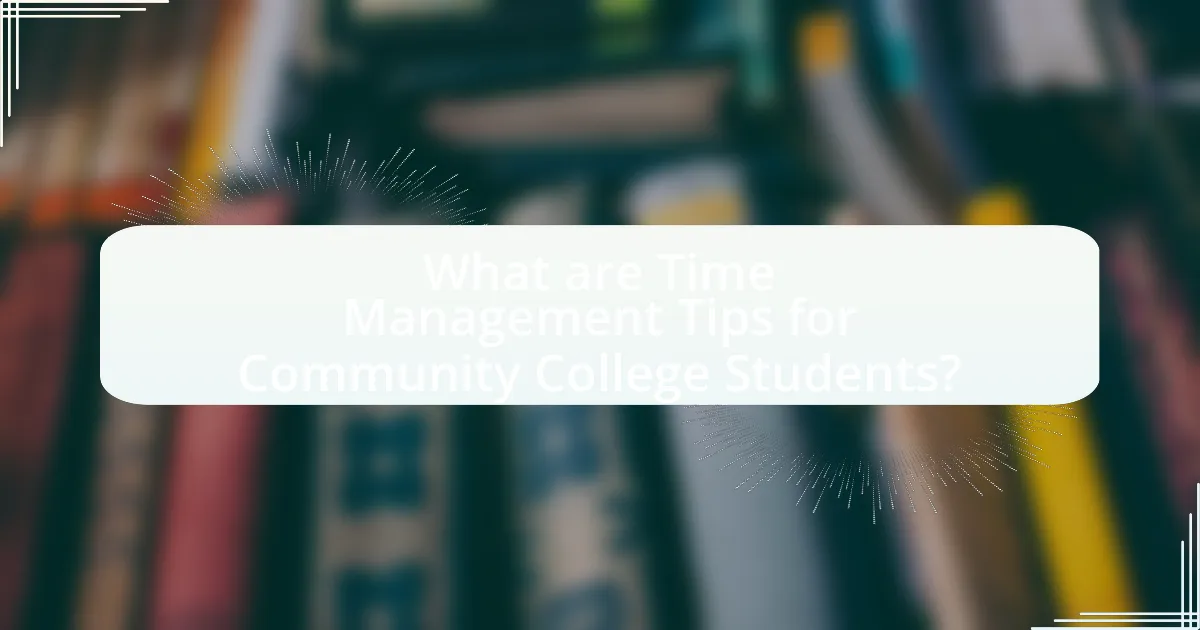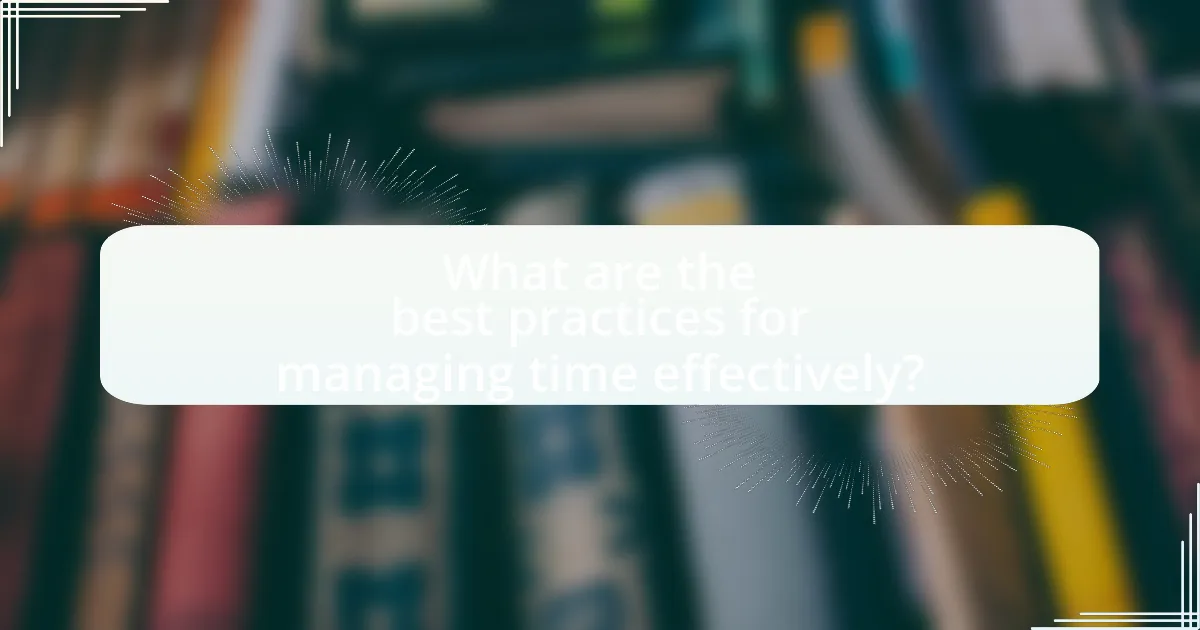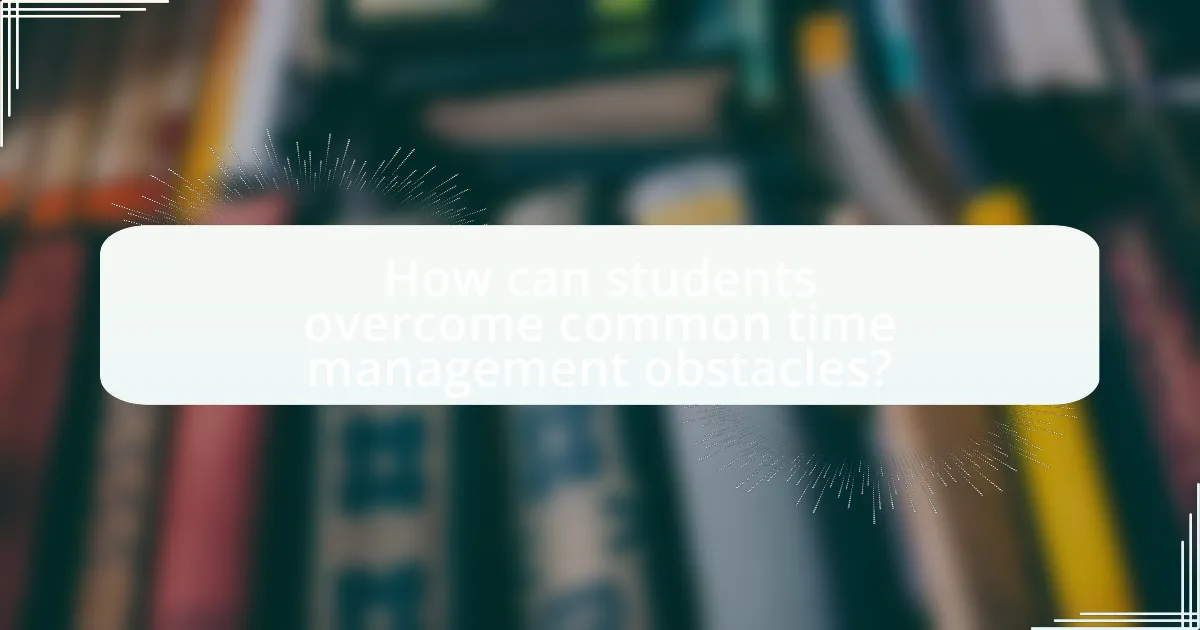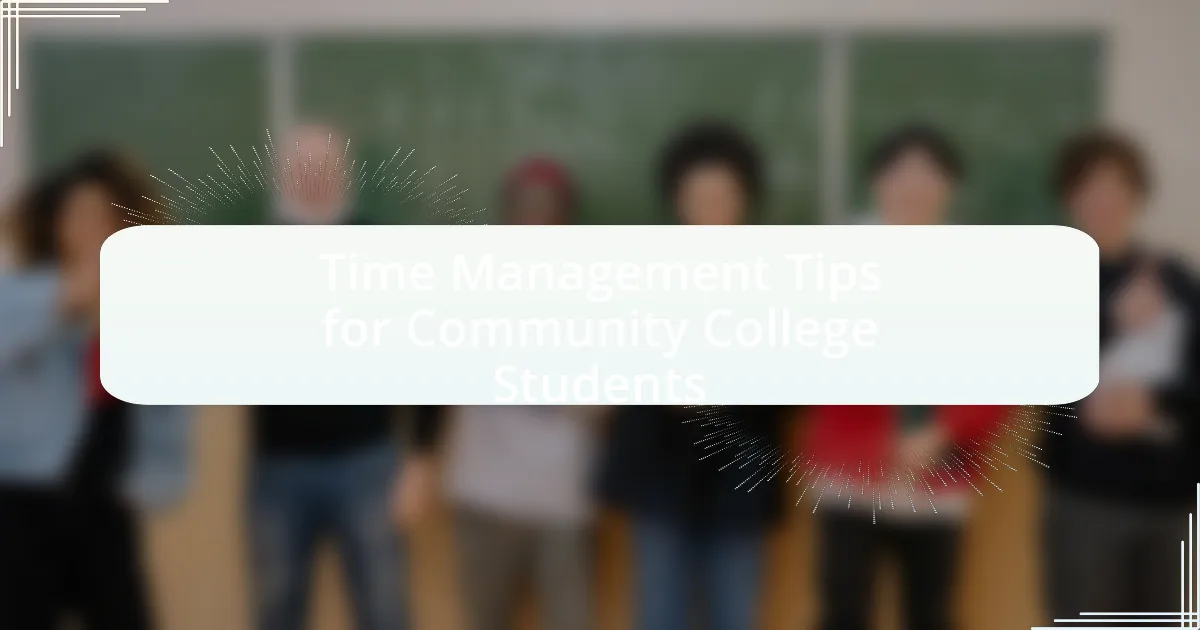The article focuses on time management tips specifically tailored for community college students, emphasizing the importance of effective strategies to enhance academic performance and reduce stress. Key topics include prioritizing tasks, creating structured schedules, and utilizing tools such as planners and digital calendars. The article also explores the impact of time management on study habits, stress levels, and overall life balance, while addressing common challenges faced by students. Additionally, it provides practical techniques, such as the Pomodoro Technique and methods for creating prioritized to-do lists, to help students improve their time management skills and achieve their academic goals.

What are Time Management Tips for Community College Students?
Effective time management tips for community college students include prioritizing tasks, creating a structured schedule, and utilizing tools like planners or digital calendars. Prioritizing tasks helps students focus on what is most important, ensuring that deadlines are met and stress is minimized. A structured schedule, which includes dedicated study times, class hours, and breaks, allows students to allocate their time efficiently. Additionally, using planners or digital calendars can enhance organization by providing visual reminders of upcoming assignments and commitments. Research indicates that students who employ these strategies tend to achieve higher academic performance and lower levels of stress, as they can manage their workload more effectively.
How can effective time management improve academic performance?
Effective time management can significantly improve academic performance by enabling students to allocate sufficient time for studying, completing assignments, and preparing for exams. When students prioritize tasks and create structured schedules, they reduce procrastination and enhance focus, leading to better retention of information and higher grades. Research indicates that students who practice effective time management techniques, such as setting specific goals and breaking tasks into manageable parts, often achieve better academic outcomes. For instance, a study published in the “Journal of Educational Psychology” found that students who utilized time management strategies had a 20% increase in their overall GPA compared to those who did not.
What specific time management strategies can enhance study habits?
Effective time management strategies that can enhance study habits include the use of the Pomodoro Technique, prioritization of tasks, and the establishment of a consistent study schedule. The Pomodoro Technique involves studying for 25 minutes followed by a 5-minute break, which has been shown to improve focus and retention (Cirillo, Francesco. “The Pomodoro Technique”). Prioritizing tasks using methods like the Eisenhower Matrix helps students distinguish between urgent and important tasks, allowing them to allocate their time more effectively. Additionally, creating a consistent study schedule reinforces routine, which research indicates can lead to better academic performance (Britton, Bruce K., and Tesser, Abraham. “Effects of Time-Management Practices on College Grades”). These strategies collectively contribute to improved study habits by fostering discipline and enhancing productivity.
How does time management impact stress levels among students?
Effective time management significantly reduces stress levels among students. When students prioritize tasks and allocate specific time slots for studying, assignments, and leisure, they experience a greater sense of control over their workload. Research indicates that students who employ time management strategies report lower anxiety and stress levels, as they are less likely to procrastinate and face last-minute pressures. A study published in the Journal of Educational Psychology found that students who effectively manage their time are 20% more likely to achieve higher academic performance, which correlates with reduced stress. Thus, implementing structured time management techniques can lead to improved mental well-being for students.
Why is time management crucial for community college students?
Time management is crucial for community college students because it directly impacts their academic success and overall well-being. Effective time management allows students to balance coursework, part-time jobs, and personal responsibilities, which is essential given that approximately 70% of community college students work while studying. By prioritizing tasks and allocating specific time slots for studying, students can enhance their productivity and reduce stress, leading to better grades and a more fulfilling college experience. Studies show that students who practice good time management skills are more likely to achieve their academic goals and maintain a healthy work-life balance.
What challenges do community college students face regarding time management?
Community college students face significant challenges regarding time management, primarily due to balancing academic responsibilities with work and personal commitments. Many students juggle part-time or full-time jobs alongside their studies, which can lead to conflicting schedules and insufficient time for coursework. Research indicates that approximately 70% of community college students work while enrolled, making it difficult to allocate adequate time for studying and attending classes. Additionally, the transition to college-level coursework often requires more time for assignments and studying than students anticipate, further complicating their ability to manage time effectively.
How can understanding time management lead to better life balance?
Understanding time management can lead to better life balance by enabling individuals to prioritize tasks effectively and allocate time efficiently. When students grasp the principles of time management, they can create structured schedules that accommodate academic responsibilities, personal interests, and social activities. Research indicates that effective time management reduces stress and enhances productivity, allowing students to achieve their goals without sacrificing their well-being. For instance, a study published in the Journal of Educational Psychology found that students who practiced time management techniques reported higher academic performance and lower levels of anxiety. This demonstrates that mastering time management not only fosters academic success but also contributes to a more balanced and fulfilling life.

What are the best practices for managing time effectively?
The best practices for managing time effectively include setting clear goals, prioritizing tasks, and utilizing a planner. Setting clear goals helps students define what they want to achieve, making it easier to allocate time accordingly. Prioritizing tasks ensures that the most important and urgent activities are completed first, which can be guided by methods such as the Eisenhower Matrix. Utilizing a planner, whether digital or paper, allows students to visualize their schedules, deadlines, and commitments, enhancing organization and accountability. Research indicates that students who use planners report higher academic performance and reduced stress levels, demonstrating the effectiveness of these time management strategies.
How can students prioritize their tasks effectively?
Students can prioritize their tasks effectively by using the Eisenhower Matrix, which categorizes tasks based on urgency and importance. This method helps students distinguish between what needs immediate attention and what can be scheduled for later, ensuring that they focus on high-priority tasks first. Research indicates that effective prioritization can lead to improved academic performance and reduced stress levels, as students are better able to manage their workload and deadlines. By regularly assessing their tasks through this framework, students can enhance their time management skills and achieve their academic goals more efficiently.
What methods can be used to create a prioritized to-do list?
To create a prioritized to-do list, students can use methods such as the Eisenhower Matrix, ABC prioritization, and the MoSCoW method. The Eisenhower Matrix categorizes tasks into four quadrants based on urgency and importance, helping students focus on what truly matters. ABC prioritization involves labeling tasks as A (high priority), B (medium priority), or C (low priority), allowing for a clear hierarchy of tasks. The MoSCoW method classifies tasks into Must have, Should have, Could have, and Won’t have, which aids in determining essential tasks versus those that can wait. These methods enhance productivity by ensuring that students allocate their time effectively to the most critical tasks.
How does setting deadlines improve task management?
Setting deadlines improves task management by creating a sense of urgency that motivates individuals to prioritize and complete tasks efficiently. When deadlines are established, they provide clear timeframes for task completion, which helps in organizing workload and reducing procrastination. Research indicates that individuals who set specific deadlines are more likely to achieve their goals, as deadlines enhance focus and accountability. For instance, a study published in the Journal of Applied Psychology found that setting deadlines significantly increased task completion rates among students, demonstrating the effectiveness of this strategy in managing time effectively.
What tools and resources can assist in time management?
Digital tools such as calendar applications, task management software, and time tracking apps can significantly assist in time management. Calendar applications like Google Calendar allow users to schedule classes, assignments, and personal commitments, providing reminders and visual organization. Task management software, such as Trello or Asana, helps students prioritize tasks and track progress on projects, enhancing productivity. Time tracking apps, like Toggl, enable users to monitor how much time is spent on various activities, allowing for better allocation of time and identification of areas for improvement. These tools collectively support effective time management by promoting organization, prioritization, and self-awareness in time usage.
What digital tools are available for scheduling and reminders?
Digital tools available for scheduling and reminders include Google Calendar, Microsoft Outlook, and Todoist. Google Calendar allows users to create events, set reminders, and share calendars with others, making it ideal for collaborative scheduling. Microsoft Outlook integrates email and calendar functionalities, enabling users to manage appointments and tasks efficiently. Todoist is a task management app that helps users organize tasks and set deadlines, providing reminders for upcoming due dates. These tools enhance time management by facilitating organization and ensuring important tasks are not overlooked.
How can planners and calendars be utilized for better organization?
Planners and calendars can be utilized for better organization by providing a structured framework for scheduling tasks, deadlines, and appointments. By consistently recording assignments, due dates, and personal commitments, students can visualize their time and prioritize effectively. Research indicates that students who use planners report higher academic performance and reduced stress levels, as they can manage their workload more efficiently. For instance, a study published in the Journal of Educational Psychology found that students who regularly utilized planners achieved better grades due to improved time management skills.

How can students overcome common time management obstacles?
Students can overcome common time management obstacles by implementing structured planning techniques. Utilizing tools such as planners or digital calendars allows students to visualize their schedules, prioritize tasks, and allocate specific time slots for studying, assignments, and personal activities. Research indicates that students who use time management tools report higher academic performance and lower stress levels, as they can effectively balance their responsibilities. For instance, a study published in the Journal of Educational Psychology found that students who engaged in systematic planning improved their grades by an average of 20%.
What are the most common distractions for community college students?
The most common distractions for community college students include social media, part-time jobs, family responsibilities, and personal relationships. Social media platforms often consume significant time, with studies indicating that students can spend over two hours daily on these sites, detracting from their study time. Part-time jobs, while necessary for financial support, can lead to fatigue and reduced study hours. Family responsibilities, such as childcare or household duties, further divide attention and time. Additionally, personal relationships can create emotional distractions, impacting focus and academic performance. These factors collectively hinder effective time management and academic success among community college students.
How can students minimize distractions while studying?
Students can minimize distractions while studying by creating a dedicated study environment. This involves selecting a quiet space free from interruptions, such as a library or a designated room at home. Research indicates that a clutter-free and organized workspace enhances focus and productivity, as evidenced by a study published in the Journal of Environmental Psychology, which found that individuals in tidy environments performed better on tasks requiring concentration. Additionally, students should limit digital distractions by turning off notifications on devices and using apps that block distracting websites during study sessions. Implementing these strategies can significantly improve concentration and study effectiveness.
What techniques can help maintain focus during study sessions?
To maintain focus during study sessions, techniques such as the Pomodoro Technique, minimizing distractions, and setting specific goals are effective. The Pomodoro Technique involves studying for 25 minutes followed by a 5-minute break, which has been shown to enhance concentration and productivity. Minimizing distractions includes turning off notifications and creating a dedicated study space, which research indicates can significantly improve focus. Setting specific, achievable goals for each study session helps to provide direction and motivation, leading to more effective learning outcomes.
How can students develop a consistent routine?
Students can develop a consistent routine by establishing a structured schedule that includes dedicated time for classes, study sessions, and personal activities. This approach helps in creating predictability in daily tasks, which is essential for effective time management. Research indicates that individuals who follow a consistent routine experience improved focus and productivity, as routines help in minimizing decision fatigue and distractions. For instance, a study published in the Journal of Educational Psychology found that students who adhered to a regular study schedule achieved higher academic performance compared to those with irregular study habits. By prioritizing tasks and setting specific time blocks for each activity, students can cultivate a routine that enhances their academic success and overall well-being.
What steps can be taken to establish a daily schedule?
To establish a daily schedule, begin by identifying your priorities and tasks for the day. This involves listing all activities, including classes, study sessions, work commitments, and personal time. Next, allocate specific time blocks for each task, ensuring to include breaks to maintain productivity. Utilize tools such as planners or digital calendars to visualize your schedule and set reminders for important deadlines. Research indicates that structured scheduling can enhance time management skills, leading to improved academic performance among students (Britton & Tesser, 1991).
How does consistency in routine contribute to effective time management?
Consistency in routine significantly enhances effective time management by establishing predictable patterns that reduce decision fatigue and increase productivity. When individuals adhere to a consistent routine, they allocate specific time slots for tasks, which minimizes procrastination and maximizes focus. Research indicates that routines can lead to improved efficiency; for example, a study published in the Journal of Experimental Psychology found that individuals who followed a structured daily routine completed tasks more quickly and with higher quality than those who did not. This structured approach allows community college students to prioritize their academic responsibilities while balancing other commitments, ultimately leading to better time management outcomes.
What practical tips can enhance time management skills?
To enhance time management skills, prioritize tasks using the Eisenhower Matrix, which categorizes tasks into four quadrants based on urgency and importance. This method allows individuals to focus on what truly matters, reducing time spent on less critical activities. Research indicates that effective prioritization can lead to a 25% increase in productivity, as individuals allocate their time to high-impact tasks rather than distractions. Additionally, setting specific goals and deadlines can create a sense of urgency, further improving time management. Studies show that individuals who set clear goals are 10 times more likely to achieve them, reinforcing the importance of structured planning in managing time effectively.
How can students implement the Pomodoro Technique for better focus?
Students can implement the Pomodoro Technique for better focus by breaking their study time into intervals, typically 25 minutes of focused work followed by a 5-minute break. This method enhances concentration and reduces mental fatigue, as supported by research indicating that short breaks can improve overall productivity and retention of information. To effectively use this technique, students should set a timer for 25 minutes, work on a specific task until the timer goes off, then take a 5-minute break to recharge. After completing four cycles, a longer break of 15-30 minutes is recommended, allowing for deeper relaxation and improved focus in subsequent sessions.
What role does self-reflection play in improving time management?
Self-reflection plays a crucial role in improving time management by enabling individuals to assess their current habits and identify areas for enhancement. Through self-reflection, students can evaluate how they allocate their time, recognize patterns of procrastination, and determine which activities yield the most productive outcomes. Research indicates that self-reflection fosters greater self-awareness, which is essential for making informed decisions about time allocation. For instance, a study published in the Journal of Educational Psychology found that students who engaged in regular self-reflection demonstrated improved academic performance and better time management skills. This evidence supports the assertion that self-reflection is a vital tool for enhancing time management effectiveness among community college students.

Leave a Reply